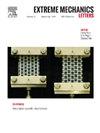细长梁在横向受力下的早期断裂
IF 4.5
3区 工程技术
Q2 MATERIALS SCIENCE, MULTIDISCIPLINARY
引用次数: 0
摘要
压缩屈曲梁在横向受力下的滞回断裂是许多器件和机械超材料的基础。对于单尖端横向推挤器,一个重要的限制是,冲压需要推挤器穿过光束的纵轴。在这里,我们表明,双尖端的推杆允许早发作的折断,其中光束折断之前,推杆到达纵轴。因此,我们表明,当压缩增加的弯曲梁与双尖端推力器接触时,它可以向相反方向折断-这是单尖端推力器不可能做到的。此外,我们揭示了一种新的两步捕捉机制,其中光束依次失去与双尖端推杆的两个尖端的接触。为了描述这类断裂不稳定性,我们采用了梁形的系统模态展开。这种扩展使我们能够捕捉和分析从一步到两步的几何转换。最后,我们演示了如何最大限度地提高推杆与梁的纵轴之间的距离。总之,我们的工作为定量和定性控制和修改屈曲梁的断裂开辟了一条新的途径,在机械传感器、致动器和超材料中具有潜在的应用前景。本文章由计算机程序翻译,如有差异,请以英文原文为准。
Early onset of snapping of slender beams under transverse forcing
The hysteretic snapping under transverse forcing of a compressed, buckled beam is fundamental for many devices and mechanical metamaterials. For a single-tip transverse pusher, an important limitation is that snapping requires the pusher to cross the longitudinal axis of the beam. Here, we show that dual-tip pushers allow early-onset snapping, where the beam snaps before the pusher reaches the longitudinal axis. As a consequence, we show that when a buckled beam under increased compression comes in contact with a dual-tip pusher, it can snap to the opposite direction — this is impossible with a single-tip pusher. Additionally, we reveal a novel two-step snapping regime, in which the beam sequentially loses contact with the two tips of the dual-tip pusher. To characterize this class of snapping instabilities, we employ a systematic modal expansion of the beam shape. This expansion allows us to capture and analyze the transition from one-step to two-step snapping geometrically. Finally we demonstrate how to maximize the distance between the pusher and the beam’s longitudinal axis at the moment of snapping. Together, our work opens up a new avenue for quantitatively and qualitatively controlling and modifying the snapping of buckled beams, with potential applications in mechanical sensors, actuators, and metamaterials.
求助全文
通过发布文献求助,成功后即可免费获取论文全文。
去求助
来源期刊

Extreme Mechanics Letters
Engineering-Mechanics of Materials
CiteScore
9.20
自引率
4.30%
发文量
179
审稿时长
45 days
期刊介绍:
Extreme Mechanics Letters (EML) enables rapid communication of research that highlights the role of mechanics in multi-disciplinary areas across materials science, physics, chemistry, biology, medicine and engineering. Emphasis is on the impact, depth and originality of new concepts, methods and observations at the forefront of applied sciences.
 求助内容:
求助内容: 应助结果提醒方式:
应助结果提醒方式:


